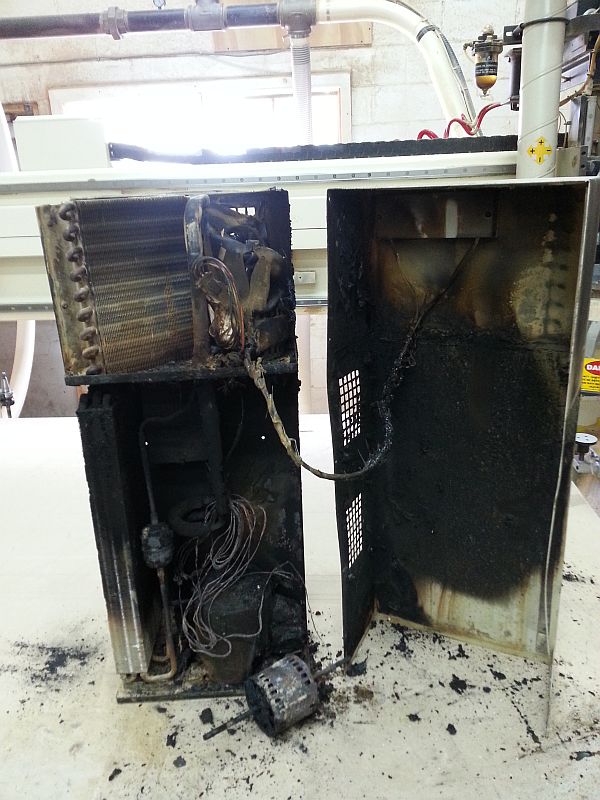Question
If you were to start a new shop, would you have a CNC and a beam saw, or would you have two CNCs? Why?
Forum Responses
(CNC Forum)
From contributor F:
What kind of shop? Sign, cabinet, furniture, or POP work?
We are near capacity on the router and have considered a second. No way go the PTP and saw. Double handling! Even for just cutting rectangles the router is at least as fast as the beam saw, if single sheet cutting.
If I were to start from scratch: a 5x12 router with auto loading and push-off while cleaning the bed. Unless you are going to be stack cutting rectangles that won't be face detailed, I'd go for a second router. Having a second router gives you a backup. As we are now, if our router were to go down, things would almost stop.
I'd definitely use conveyors rather than carts. They have been a big improvement here. Less labor, forced organization. One of the next additions here will be a gantry crane and floor conveyors to hold units of the most commonly used materials within reach for loading both the saw and router. Should save the time of using the forklift to store and retrieve every change of materials. Our solid wood processing area uses carts. It may be possible to use conveyors there, but the long lengths could be an issue depending on shop layout.
We still use our slider for odd and end things. Still have a 12/14" saw and feed, a SawStop, SL rip, assorted shapers (several just left setup for one use) Weinig molder, grinder, widebelt, etc. Given the number of "etc." there are, I'd leave plenty of room for adding more of them. We have too many almost obsolete tools that don't get much use. Our final assembly area/shipping can hold up to two semi loads of finished work, but not function well at that level.
It sure would be nice to start from scratch, and really expensive too. This shop has been built up over 24 years.
I previously ran a beam saw and ptp and converted to nested base about 9 months ago. Before I made the change, I did time studies on things to see the difference. For example, on our beam saw, to load and just cut a 4x8 sheet on all 4 sides would take approximately 5 minutes. The other day I ran an 8 sheet job and tracked the time to machine and unload on the CNC. Average time to run parts was 6 minutes per sheet with all machining complete. Time to mark, unload, clean table and load next sheet was 4-6 minutes.
If I was starting from scratch today, I would buy a nested base machine with fully automated loader and a ride along bar code printer. This setup would have the machine running the next sheet in 1/3 the time of manual offloading.
The other thing with the CNC is you can add things that you wouldn't normally do to help ease assembly and install. For example, our garage cabinet backs have shelf holes in them and a top. Many times the top hadn't been marked and a lazy employee wouldn't pay attention and the back ended up installed upside down. We now place a 5mm hole at the top of the cut line to denote the top. In 2 seconds we removed the possibility of human error in that step.
Contributor M, please tell me why you went through so many spoil boards that they are considered a major expense? We regularly run 20 sheets a day, 5 days a week and just put our 4th one on in the last nine months.
We are running a 40hp pump so hold is relatively good even with a dinged up board.
Comment from contributor A:
For the last 11 years our shop has been using a PTP router in a combination at first with a vertical panel saw, and then seven years ago replaced it with a beam saw. Now I have the beam saw PTP combo and have recently brought in a nested base router so I have personal experience with all combos. If I was starting out I would definitely get a nested base with at least a push off device.
Having the BS-PTP combo and doing 40 percent of our business being commercial and the rest high-end residential I am finding that my nested 5x12 with a push off device can still beat my BS-PTP time in almost all instances. When cutting three sheets high, which is not typical for us in most cases, we cut one sheet 70% of the time, two sheets 22%, and three sheets 8 % of time.
It also seems that acquiring a good beam saw and point to point is going to be more expensive than purchasing a good nested-base. With all options it is actually less expensive. One thing to keep in mind is that it would be best to have software. Maybe you already have that, but either way you go software on machines is a good idea.
